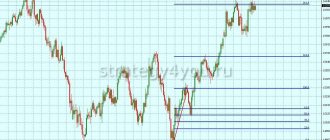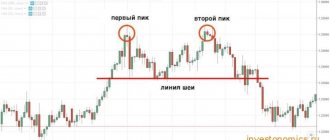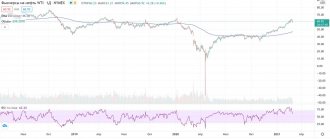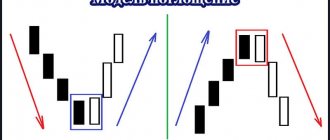Every novice investor hopes that his investments will bring only profit. Obviously, this idea is erroneous, since it is unlikely, one might say, impossible to guess with 100% probability that the asset you have chosen will always increase in price. But there is always a way out - this is the averaging strategy.
The beauty of this technique is that it is extremely simple, but at the same time extremely effective. It is based on a rule based on many years of research of the market and its players, ranging from private traders to the largest investment companies, which states:
no one knows exactly when to enter and exit the market
In a limited period of time, many guess the entry points by buying assets that show simply colossal growth. But even such investors make mistakes in their forecasts over time, when after entering the market, the price turns in the opposite direction and they begin to lose money. Sometimes a lot of money.
It is precisely to level out such situations that the position averaging technique was invented.
What is averaging?
Averaging is a gradual increase in a trading position in parts in order to quickly recover from losses or increase profits.
It is useless to explain this term in words; it will be much more effective to immediately look at the graph.
Click to enlarge.
As you can see, we first entered into the first sell trade on gold, and the market went against us. In the hope that the situation would change, another position was opened to quickly get out of the loss. Further, in the same way the third, etc. There can be an infinite number of such transactions.
As a result, when the market moves at least a little in our direction, we simply close all positions in plus and make a profit.
Excel spreadsheet for calculating knee risk averaging
Download link – file for calculating knees averaging + formula for calculating the cost of a point
Formula for calculating pip value
This value is calculated using the formula:
PointValue = (ContractSize * (Price + PointStep)) – (ContractSize * Price)
Using the EURUSD pair as an example, we can calculate that: PointValue EURUSD =(100,000 (size of 1 contract)*(1.1090(current price)+0.0001(minimum change in quote)-(100,000*1.1090)=10 USD price of one point .
Using WTI oil as an example, we can calculate that: PointValue WTI =(10(contract size)*(62.40(current price)+0.01(minimum change in quote)-(10*62.4)=62.41 -62.4=0.1USD (10 cents) price of one point.
Strategies and types of averaging
Averaging can be of two types:
- 1. For losses. 2. For profit.
More details about each below.
For losses
Beginners often like to average out losses, and professional investors do not disdain this approach. Just a similar example was given above with gold, so I will not repeat it. In the trading environment, it is believed that this approach will only lead to losses.
“Just because a stock has fallen in value does not mean it will go down. I never buy during a bear trend or sell during a rally... I caution you against averaging out your losses.” Jesse Livermore.
Although I don’t believe in truisms and check everything in practice, this advice is definitely worth listening to.
At a profit
Averaging profitable trades, on the contrary, is encouraged by many famous traders and for good reason. Huge fortunes were made on the stock exchange during protracted rallies. All you had to do was buy and hold the position. Here is an example of such averaging based on the recent surge in gold.
I still remember how I made my first profit in just this way. Then there was a strong bearish trend in the Eurodollar 2014 - 2015, and I invested about $100 into an account at Forex Club, which I turned into $700 by averaging profits. Up to this point, I received mostly losses or insignificant income.
The market was falling for a whole year, if I had more experience, time and money then, I could have made decent money. In practice, the entire averaging process was very spontaneous, since I opened trades from my phone between breaks at my day job. After such success, I still managed to lose $5,000, some of which was also with this broker. Therefore, you should not delude yourself with profit.
Should an investor average?
The averaging method, despite all its shortcomings, can be a good way to make money. Those who approach the crisis with a lot of cash can exploit the situation in two ways:
- reduce the break-even point to increase profits when selling after the market recovers;
- reduce the average purchase price of shares in order to increase exchange rate income and the level of dividend yield.
I also recommend reading:
Why are SPACs needed?
SPAC companies or how to get to the stock exchange through the back door
The main thing that an investor should avoid when trying to apply the averaging method is haste. The interactive chart of the Moscow Exchange index for the first three months of 2022 shows: those who began to act in February became victims of their haste.
Of course, we can never say with certainty whether we have reached the bottom or not yet, being in a drawdown. Therefore, you should follow three simple rules:
- Never spend your entire financial reserve at once. Always leave money in case the quotes drop even lower. It is also necessary to remember the integrity of the airbag.
- Buy only reliable companies that are guaranteed to survive the crisis. For example, choose players with state participation or large private companies with a stable cash flow.
- Do not allow a strong dominance of any security in the portfolio. Attempts to average positions can lead to distortion and disrupt the planned proportions of diversification.
A popular strategy using position averaging
Each trader independently determines the procedure for controlling risk and opening transactions. Averaging is more of a money management strategy. Very often on forums and in books there is an approach to gradually adding to profitable positions when trading in a trend. At one time I myself used this approach, which I still do periodically.
The idea is to first enter the market with a small lot and then increase it. Example of division into parts:
- 1. 10% of the planned volume; 2. 20%; 3. 30%; 4. 40%.
If you make a mistake, you will most likely realize it immediately, having lost a little (10 times less than opening with the entire volume). Otherwise, you can quickly increase your position and make money on the trend.
And what is the result?
You should perceive the above as a fairly risky money management technique, and not make it a permanent trading strategy. In the short term, for example, within a day, this method is used extremely rarely.
We categorically do not recommend getting carried away with this tactic; it requires confident experience and strong nerves for constant control. Averaging in trading is not a cure for losses, but a supportive therapy, and temporary, until the trader finds a more effective solution. But with a reasonable approach to risk, competent averaging can increase the profit from one successful entry several times.
Advantages and disadvantages of averaging
Pros: • on a pullback in a trend, under favorable circumstances, you can reduce losses; • the profit potential in prolonged movements is not limited; • allows you to earn money even when you make a mistake with the forecast (as well as for beginners who know nothing about analytics and strategies).
Disadvantages: • a trend reversal will destroy the deposit, since averaging usually implies the absence of stop losses (the exception is if you place them very far from current prices); • with an active increase in positions and profits, a sharp collapse in quotes can take away all available income; • dangerous to use in combination with high leverage (what is this?); • psychological difficulty of application (it will be difficult for you to come to terms with losses).
What is better: averaging or closing?
It is strictly not recommended to use averaging if you
- newbie and hearing about this tactic for the first time;
- use high leverage - from 1:100 and above (especially on Forex);
- the current trend has been going on for quite a long time and trading volumes in its direction are decreasing.
By the way, with high leverage, it is not recommended to average even profitable positions; it is better to use the standard TakeProfit / StopLoss combination.
You can average open orders if
- you are at a loss, but fundamental and technical analysis show at least a medium-term trend, and the current movement against the trend can be considered a correction;
- you are in profit, but there is a reliable trading signal in the direction of the open order.
Efficiency: to average or not?
Despite the extreme negativity regarding averaging, I believe that it is possible to use it if you have experience. As they say, a machine gun in the hands of a monkey is one thing, but in a soldier it’s something completely different.
When you shouldn't average:
• If you are a beginner. In this case, I strongly advise against practicing averaging, since your deposit will end very quickly. • You have high leverage (1:10 and above). As for forex traders, in this market I also do not recommend adding to losses or profits. Better fixed stop and take profit. • The trend has been going on for a very long time. In this case, you should not open, since a reversal will occur at any moment and will cut off most of your income.
Averaging is encouraged in the following cases:
• In the stock market in assets that are popular and have a long upward trend, but are sagging due to the economic crisis. • You trade without leverage, otherwise averaging will increase your risks too much. This point can be combined with the previous one, since they must be performed simultaneously. • Adding to profitable positions at the very beginning of a trend.
In practice, the effectiveness of averaging can improve your trading results several times. For example, in the above example about the first earnings on EURUSD, I was able to squeeze 3-5 times more out of the movement, although I took a lot of risk.
Averaging works best in the stock market, as I wrote about above. Here is a typical case where you can earn huge money on Russian assets and not worry about the current trend.
For each transaction it was possible to make a profit of 100–300%. This example is rather “stretched” to be obvious. In practice, investors take profits earlier. In this case, it was also possible to calmly close with a profit and after 3–4 years, of course, only the most desperate can wait 10 years. However, time in the stock market is a trader’s ally, not his enemy, as the above chart clearly illustrates.
Averaging - how to make a profit?
The point is this. For example, you made a counter-trend trade on Sberbank and went short with 1 contract at a price of 18,000 (example below). The goal for the transaction is 17,900. The goal is to close the position with a loss of 18,200. That is, this is the price at which you will close the position in any case if it goes against you. Moreover, if the instrument reaches the price of 18,100, you will buy 1 contract; if it reaches 18,200, you will close the position with the entire volume. The following is important here. Before starting a position, you calculate the volume for entering a position based on possible one-time averaging! At the same time, if you have a risk of 1% for each trade (for example, 300 rubles), then based on this you need to calculate the entry volume. Before entering a position, you understand that at a price of 18,100 you will lose 100 rubles, in this case you average and at a price of 18,200 you already lose 300 rubles and close the position. In this case, the transaction turns out to be controlled, taking into account the risk inherent in it. It is precisely in such a situation that this approach can bear fruit. With strict adherence to risk management and if you do not mindlessly average out a losing position, and this is part of your trading system. There are even some formations in which this approach can work well (in separate articles I will return to this topic and talk about a couple of such formations).
Read more about money management in trading by following the link.
Personally, I sometimes use averaging, for example, for one of my countertrend formations. At the same time, I go under the volume, based on possible averaging. And also, I never average more than once. By the way, I personally always use one risk for every transaction and on any instrument.
I guess I'll end here. I hope this article will be useful to you and everyone will be able to highlight something new from it. Profit to everyone!
Sincerely, Stanislav Stanishevsky.
conclusions
Averaging is the additional opening of transactions as the market moves. It can be done against the background of losses in order to quickly get into profit, or on the basis of a profitable position to increase income. As a general rule and the belief of many traders, it is better not to use averaging strategies, since they increase risks. This is true, but it is only true for beginners trading with huge leverage in Forex. If you buy growing shares on the stock market without a loan from a broker, then this strategy is quite effective and allows you to earn money without any special skills.
Author: Alexey Shlyapnikov.
Criticism, gratitude and questions in the comments are welcome! :))
Main
- Investments require time to immerse themselves in the topic; past performance does not guarantee future returns.
- It is important to make informed financial decisions, invest regularly, and use an averaging strategy to protect yourself from market fluctuations.
- Averaging has an effect over a long-term investment horizon. For example, from the year.
- It is important to remember that averaging does not guarantee the absence of losses and is not a prerequisite for achieving profitability in investments. All other things being equal, this strategy allows you to increase potential income, as well as reduce possible losses.
Edlson method
In addition to the classical scheme, there is also an alternative averaging method, which was proposed by the American scientist Edlson.
The point is this.
Let's assume that I set a goal to invest 120,000 rubles in shares of a selected company within one year. At the same time, the value of my portfolio in the first month should be 10,000 rubles, and in each subsequent month 10,000 rubles more than in the previous reporting period.
For example, it’s July and I’m investing 10,000 rubles. In August, the value of my portfolio should be 10,000 more, i.e. be 20,000 rubles, in September - 30,000 rubles, in October - 40,000 rubles, and so on.
This is the target value of the portfolio and will need to be compared with the actual value every month. If the actual one on the agreed day of the month is lower than the target one, I buy additional shares, regardless of their current price. If the actual cost is equal to or higher than the target cost, then I do not make a purchase.
I plan to buy shares on a certain day of the month until the annual limit expires, i.e. my 120,000 rubles. Thus, they may run out before the year if the stock price is low.
Now I will explain this method with a specific example.
I chose a certain stock. In the first month of my investment, their price was 5,000 rubles. I buy 2 shares and thus the actual value of my portfolio reaches the target value of 10,000 rubles.
In the second month, the share price soared to 10,000 rubles, respectively, the value of my portfolio reached 20,000 rubles on its own. It turns out that I don’t need to buy anything additional.
For the third month, the share price fell to the original 5,000 rubles. The actual value of the portfolio was 10,000 rubles. But in the third month, the target price should be at the level of 30,000 rubles, so I need to buy additional shares for 20,000 rubles. I take 4 shares (20,000 / 5,000 = 4). In total, I will have 6 shares in my portfolio.
And so on.
How amateurs and professionals invest
Most amateurs in the market do not have a long-term strategy and make decisions based on current news and market sentiment. When things go up, amateurs see others making money and start taking positions too. When markets crash, fear forces amateurs to sell.
They are afraid that everything will collapse, the financial world will “fall into the abyss”, the shares of the chosen ones will never recover. Therefore, we need to quickly save our assets. The result is the following picture.
How do amateurs invest in the stock market?
Some fans are still trying to speculate. When markets rise or fall, they try to catch the "bottom" or "top" of the market. More often they fail than they succeed. But the worst thing is that they confuse speculation and long-term investment.
Long-term professional investors (banks, funds, insurance companies, individuals) always buy.
How do professionals invest?
They regularly invest in those securities that they want to see in their portfolio for many years, or better yet, to pass on to their children for the rest of their lives. They do not try to guess and catch the “bottom” or “top” of the market. They just buy. When markets rise, they buy less (the price rises, the number of shares and shares purchased becomes less), when markets decline, they buy more.
That's the whole secret of how to accumulate large capital in the stock market. Select good stocks (or funds) that you would like to see in your portfolio over the next 20-30 years. Or better yet, your whole life. And regularly invest in this portfolio despite crises and news on TV.











